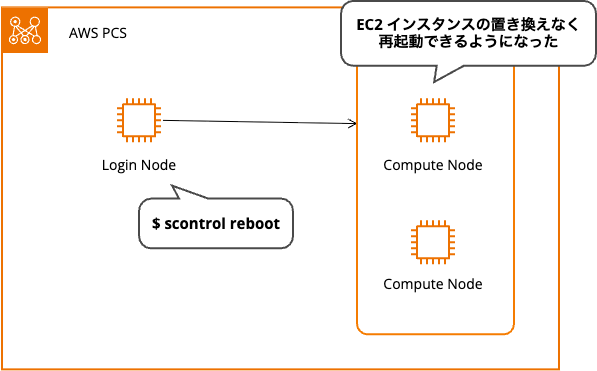
AWS PCS が EC2 インスタンスの置き換えなしのコンピュートノード再起動機能をサポートしました
はじめに
2025 年 10 月、AWS Parallel Computing Service (PCS) で Slurm のコンピュートノード再起動機能がサポートされました。
EC2 インスタンスを置換せずにコンピュートノードを再起動できます。Slurm のネイティブコマンドを使用したノード管理ができます。

Slurm ノード再起動機能とは
AWS PCS では、Slurm の scontrol reboot コマンドを使用してコンピュートノードを再起動できるようになりました。
従来、EC2 コンソールや AWS CLI、自動パッチなどで再起動すると、AWS PCS はインスタンスを正常ではない状態とみなして新しいインスタンスに置換していました。今回のアップデートにより、インスタンス置換を伴わない再起動が可能になります。
メリット
Slurm ノード再起動機能には、以下のメリットがあります。
- キャパシティの保持
- キャパシティが少ないインスタンスを他の顧客に取られることなく維持できる
- コスト削減
- インスタンス置換にかかる時間の短縮
- リカバリ時間の短縮
- インスタンス置換と比較するとコンピュートノードが利用可能になるまでが早くなる
- 運用の柔軟性
- メモリリークのクリア、一時ファイルの削除、劣化状態からのノードリカバリが可能
制限事項
Slurm ノード再起動機能には制限があります。Slurm Admin ユーザー(root ユーザー)のみが scontrol reboot コマンドを実行できます。また、サポートされるコマンドは scontrol reboot のみです。
ジョブ実行中の再起動について
再起動時のジョブの扱いは、指定するオプションによって異なります。
デフォルトの動作
オプションを指定しない場合、ジョブが正常に完了してから再起動します。
ASAP オプション使用時
ASAP オプションを使用するとノードがドレイン状態になり、新しいジョブの投入が防止されます。現在実行中のジョブが完了した後に再起動が発生します。
すぐに再起動したい場合
すぐに再起動したい場合は、2 つの方法があります。
1 つ目は、ジョブをキャンセルしてから再起動する方法です。
scancel <job_id> でジョブをキャンセルしてから、scontrol reboot ASAP <nodename> で即座に再起動します。実行中のジョブは終了するため、ノードリカバリ後に再投入が必要です。
2 つ目は、ドレインしてリキューする方法です。
scontrol reboot ASAP <nodename> で再起動を開始してから、scontrol requeue <job_id> でジョブをリキューします。ジョブはキャンセルではなく待機状態に戻ります。この方法は影響が少ないです。
試してみた
AWS PCS でコンピュートノード再起動機能を試してみました。
検証環境
本記事の検証には、以下の構成で AWS PCS クラスターを構築しました。
| 項目 | 設定値 |
|---|---|
| リージョン | 東京リージョン(ap-northeast-1) |
| Slurm バージョン | 25.05.3 |
| ログインノード | t3.micro × 1 台 |
| コンピュートノード | m7i.large × 最大 4 台 |
| 共有ストレージ | Amazon EFS |
構築に使用した CloudFormation テンプレートです。
CloudFormation テンプレート
AWSTemplateFormatVersion: '2010-09-09'
Description: 'Simple AWS PCS cluster for verification - 1 login node (t3.micro) and up to 4 compute nodes (m7i.large) with EFS storage'
Parameters:
ClusterName:
Type: String
Default: 'simple-pcs-cluster'
Description: 'Name of the PCS cluster'
AMIID:
Type: AWS::EC2::Image::Id
Default: 'ami-056a2dabd78ff3886'
SlurmVersion:
Type: String
Default: '25.05'
Description: 'Slurm version for the PCS cluster'
AllowedValues:
- '25.05'
- '24.11'
Resources:
# VPC
VPC:
Type: AWS::EC2::VPC
Properties:
CidrBlock: '10.0.0.0/16'
EnableDnsHostnames: true
EnableDnsSupport: true
Tags:
- Key: Name
Value: !Sub '${ClusterName}-vpc'
# Internet Gateway
InternetGateway:
Type: AWS::EC2::InternetGateway
Properties:
Tags:
- Key: Name
Value: !Sub '${ClusterName}-igw'
InternetGatewayAttachment:
Type: AWS::EC2::VPCGatewayAttachment
Properties:
InternetGatewayId: !Ref InternetGateway
VpcId: !Ref VPC
# Public Subnet
PublicSubnet1:
Type: AWS::EC2::Subnet
Properties:
VpcId: !Ref VPC
AvailabilityZone: !Select [0, !GetAZs '']
CidrBlock: '10.0.1.0/24'
MapPublicIpOnLaunch: true
Tags:
- Key: Name
Value: !Sub '${ClusterName}-public-subnet-1'
PublicSubnet2:
Type: AWS::EC2::Subnet
Properties:
VpcId: !Ref VPC
AvailabilityZone: !Select [1, !GetAZs '']
CidrBlock: '10.0.2.0/24'
MapPublicIpOnLaunch: true
Tags:
- Key: Name
Value: !Sub '${ClusterName}-public-subnet-2'
PublicSubnet3:
Type: AWS::EC2::Subnet
Properties:
VpcId: !Ref VPC
AvailabilityZone: !Select [2, !GetAZs '']
CidrBlock: '10.0.3.0/24'
MapPublicIpOnLaunch: true
Tags:
- Key: Name
Value: !Sub '${ClusterName}-public-subnet-3'
# Private Subnet
PrivateSubnet1:
Type: AWS::EC2::Subnet
Properties:
VpcId: !Ref VPC
AvailabilityZone: !Select [0, !GetAZs '']
CidrBlock: '10.0.11.0/24'
Tags:
- Key: Name
Value: !Sub '${ClusterName}-private-subnet-1'
PrivateSubnet2:
Type: AWS::EC2::Subnet
Properties:
VpcId: !Ref VPC
AvailabilityZone: !Select [1, !GetAZs '']
CidrBlock: '10.0.12.0/24'
Tags:
- Key: Name
Value: !Sub '${ClusterName}-private-subnet-2'
PrivateSubnet3:
Type: AWS::EC2::Subnet
Properties:
VpcId: !Ref VPC
AvailabilityZone: !Select [2, !GetAZs '']
CidrBlock: '10.0.13.0/24'
Tags:
- Key: Name
Value: !Sub '${ClusterName}-private-subnet-3'
# Isolated Subnet
IsolatedSubnet1:
Type: AWS::EC2::Subnet
Properties:
VpcId: !Ref VPC
AvailabilityZone: !Select [0, !GetAZs '']
CidrBlock: '10.0.21.0/24'
Tags:
- Key: Name
Value: !Sub '${ClusterName}-isolated-subnet-1'
IsolatedSubnet2:
Type: AWS::EC2::Subnet
Properties:
VpcId: !Ref VPC
AvailabilityZone: !Select [1, !GetAZs '']
CidrBlock: '10.0.22.0/24'
Tags:
- Key: Name
Value: !Sub '${ClusterName}-isolated-subnet-2'
IsolatedSubnet3:
Type: AWS::EC2::Subnet
Properties:
VpcId: !Ref VPC
AvailabilityZone: !Select [2, !GetAZs '']
CidrBlock: '10.0.23.0/24'
Tags:
- Key: Name
Value: !Sub '${ClusterName}-isolated-subnet-3'
# NAT Gateway
NatGateway1EIP:
Type: AWS::EC2::EIP
DependsOn: InternetGatewayAttachment
Properties:
Domain: vpc
NatGateway1:
Type: AWS::EC2::NatGateway
Properties:
AllocationId: !GetAtt NatGateway1EIP.AllocationId
SubnetId: !Ref PublicSubnet1
# Route Tables
PublicRouteTable:
Type: AWS::EC2::RouteTable
Properties:
VpcId: !Ref VPC
Tags:
- Key: Name
Value: !Sub '${ClusterName}-public-routes'
DefaultPublicRoute:
Type: AWS::EC2::Route
DependsOn: InternetGatewayAttachment
Properties:
RouteTableId: !Ref PublicRouteTable
DestinationCidrBlock: '0.0.0.0/0'
GatewayId: !Ref InternetGateway
PublicSubnet1RouteTableAssociation:
Type: AWS::EC2::SubnetRouteTableAssociation
Properties:
RouteTableId: !Ref PublicRouteTable
SubnetId: !Ref PublicSubnet1
PublicSubnet2RouteTableAssociation:
Type: AWS::EC2::SubnetRouteTableAssociation
Properties:
RouteTableId: !Ref PublicRouteTable
SubnetId: !Ref PublicSubnet2
PublicSubnet3RouteTableAssociation:
Type: AWS::EC2::SubnetRouteTableAssociation
Properties:
RouteTableId: !Ref PublicRouteTable
SubnetId: !Ref PublicSubnet3
PrivateRouteTable1:
Type: AWS::EC2::RouteTable
Properties:
VpcId: !Ref VPC
Tags:
- Key: Name
Value: !Sub '${ClusterName}-private-routes-1'
DefaultPrivateRoute1:
Type: AWS::EC2::Route
Properties:
RouteTableId: !Ref PrivateRouteTable1
DestinationCidrBlock: '0.0.0.0/0'
NatGatewayId: !Ref NatGateway1
PrivateSubnet1RouteTableAssociation:
Type: AWS::EC2::SubnetRouteTableAssociation
Properties:
RouteTableId: !Ref PrivateRouteTable1
SubnetId: !Ref PrivateSubnet1
PrivateSubnet2RouteTableAssociation:
Type: AWS::EC2::SubnetRouteTableAssociation
Properties:
RouteTableId: !Ref PrivateRouteTable1
SubnetId: !Ref PrivateSubnet2
PrivateSubnet3RouteTableAssociation:
Type: AWS::EC2::SubnetRouteTableAssociation
Properties:
RouteTableId: !Ref PrivateRouteTable1
SubnetId: !Ref PrivateSubnet3
# Security Groups
LoginSecurityGroup:
Type: AWS::EC2::SecurityGroup
Properties:
GroupName: !Sub '${ClusterName}-login-sg'
GroupDescription: 'Security group for PCS login nodes'
VpcId: !Ref VPC
SecurityGroupEgress:
- IpProtocol: -1
CidrIp: 0.0.0.0/0
Description: 'Allow all outbound traffic'
Tags:
- Key: Name
Value: !Sub '${ClusterName}-login-sg'
ComputeSecurityGroup:
Type: AWS::EC2::SecurityGroup
Properties:
GroupName: !Sub '${ClusterName}-compute-sg'
GroupDescription: 'Security group for PCS compute nodes'
VpcId: !Ref VPC
SecurityGroupIngress:
- IpProtocol: tcp
FromPort: 22
ToPort: 22
CidrIp: 10.0.0.0/16
Description: 'SSH access from VPC for PCS requirement'
SecurityGroupEgress:
- IpProtocol: -1
CidrIp: 0.0.0.0/0
Description: 'Allow all outbound traffic'
Tags:
- Key: Name
Value: !Sub '${ClusterName}-compute-sg'
# Allow all traffic from login to compute
ComputeSecurityGroupIngressFromLogin:
Type: AWS::EC2::SecurityGroupIngress
Properties:
GroupId: !Ref ComputeSecurityGroup
IpProtocol: -1
SourceSecurityGroupId: !Ref LoginSecurityGroup
Description: 'Allow all traffic from login nodes'
# Allow all traffic from compute to login
LoginSecurityGroupIngressFromCompute:
Type: AWS::EC2::SecurityGroupIngress
Properties:
GroupId: !Ref LoginSecurityGroup
IpProtocol: -1
SourceSecurityGroupId: !Ref ComputeSecurityGroup
Description: 'Allow all traffic from compute nodes'
# Self-referencing rules for login nodes
LoginSecurityGroupIngressSelfRef:
Type: AWS::EC2::SecurityGroupIngress
Properties:
GroupId: !Ref LoginSecurityGroup
IpProtocol: -1
SourceSecurityGroupId: !Ref LoginSecurityGroup
Description: 'Allow all traffic within login nodes'
# Self-referencing rules for compute nodes
ComputeSecurityGroupIngressSelfRef:
Type: AWS::EC2::SecurityGroupIngress
Properties:
GroupId: !Ref ComputeSecurityGroup
IpProtocol: -1
SourceSecurityGroupId: !Ref ComputeSecurityGroup
Description: 'Allow all traffic within compute nodes'
EFSSecurityGroup:
Type: AWS::EC2::SecurityGroup
Properties:
GroupName: !Sub '${ClusterName}-efs-sg'
GroupDescription: 'Security group for EFS'
VpcId: !Ref VPC
SecurityGroupIngress:
- IpProtocol: tcp
FromPort: 2049
ToPort: 2049
SourceSecurityGroupId: !Ref LoginSecurityGroup
- IpProtocol: tcp
FromPort: 2049
ToPort: 2049
SourceSecurityGroupId: !Ref ComputeSecurityGroup
Tags:
- Key: Name
Value: !Sub '${ClusterName}-efs-sg'
# EFS
EFSFileSystem:
Type: AWS::EFS::FileSystem
Properties:
PerformanceMode: generalPurpose
ThroughputMode: bursting
Encrypted: true
FileSystemTags:
- Key: Name
Value: !Sub '${ClusterName}-efs'
EFSMountTarget1:
Type: AWS::EFS::MountTarget
Properties:
FileSystemId: !Ref EFSFileSystem
SubnetId: !Ref PrivateSubnet1
SecurityGroups:
- !Ref EFSSecurityGroup
EFSMountTarget2:
Type: AWS::EFS::MountTarget
Properties:
FileSystemId: !Ref EFSFileSystem
SubnetId: !Ref PrivateSubnet2
SecurityGroups:
- !Ref EFSSecurityGroup
EFSMountTarget3:
Type: AWS::EFS::MountTarget
Properties:
FileSystemId: !Ref EFSFileSystem
SubnetId: !Ref PrivateSubnet3
SecurityGroups:
- !Ref EFSSecurityGroup
# IAM Role for PCS Instance
PCSInstanceRole:
Type: AWS::IAM::Role
Properties:
RoleName: !Sub 'AWSPCS-${AWS::StackName}-${AWS::Region}'
AssumeRolePolicyDocument:
Version: '2012-10-17'
Statement:
- Effect: Allow
Principal:
Service: ec2.amazonaws.com
Action: sts:AssumeRole
ManagedPolicyArns:
- arn:aws:iam::aws:policy/AmazonSSMManagedInstanceCore
Policies:
- PolicyName: PCSComputeNodePolicy
PolicyDocument:
Version: '2012-10-17'
Statement:
- Effect: Allow
Action:
- pcs:RegisterComputeNodeGroupInstance
Resource: '*'
PCSInstanceProfile:
Type: AWS::IAM::InstanceProfile
Properties:
Roles:
- !Ref PCSInstanceRole
# Launch Template for Login Nodes
LoginLaunchTemplate:
Type: AWS::EC2::LaunchTemplate
Properties:
LaunchTemplateName: !Sub '${ClusterName}-login-launch-template'
LaunchTemplateData:
ImageId: !Ref AMIID
SecurityGroupIds:
- !Ref LoginSecurityGroup
IamInstanceProfile:
Arn: !GetAtt PCSInstanceProfile.Arn
UserData:
Fn::Base64: !Sub |
MIME-Version: 1.0
Content-Type: multipart/mixed; boundary="==BOUNDARY=="
--==BOUNDARY==
Content-Type: text/x-shellscript; charset="us-ascii"
#!/bin/bash
yum update -y
yum install -y amazon-efs-utils
mkdir -p /shared
echo "${EFSFileSystem}.efs.${AWS::Region}.amazonaws.com:/ /shared efs defaults,_netdev" >> /etc/fstab
mount -a
chown ec2-user:ec2-user /shared
chmod 755 /shared
# Add Slurm commands to PATH for all users
echo 'export PATH=/opt/slurm/bin:$PATH' >> /etc/profile.d/slurm.sh
chmod +x /etc/profile.d/slurm.sh
# Add to ec2-user's bashrc for immediate availability
echo 'export PATH=/opt/slurm/bin:$PATH' >> /home/ec2-user/.bashrc
chown ec2-user:ec2-user /home/ec2-user/.bashrc
--==BOUNDARY==--
MetadataOptions:
HttpTokens: required
HttpPutResponseHopLimit: 2
HttpEndpoint: enabled
# Launch Template for Compute Nodes
ComputeLaunchTemplate:
Type: AWS::EC2::LaunchTemplate
Properties:
LaunchTemplateName: !Sub '${ClusterName}-compute-launch-template'
LaunchTemplateData:
ImageId: !Ref AMIID
SecurityGroupIds:
- !Ref ComputeSecurityGroup
IamInstanceProfile:
Arn: !GetAtt PCSInstanceProfile.Arn
UserData:
Fn::Base64: !Sub |
MIME-Version: 1.0
Content-Type: multipart/mixed; boundary="==BOUNDARY=="
--==BOUNDARY==
Content-Type: text/x-shellscript; charset="us-ascii"
#!/bin/bash
yum update -y
yum install -y amazon-efs-utils
mkdir -p /shared
echo "${EFSFileSystem}.efs.${AWS::Region}.amazonaws.com:/ /shared efs defaults,_netdev" >> /etc/fstab
mount -a
chown ec2-user:ec2-user /shared
chmod 755 /shared
# Add Slurm commands to PATH for all users
echo 'export PATH=/opt/slurm/bin:$PATH' >> /etc/profile.d/slurm.sh
chmod +x /etc/profile.d/slurm.sh
# Add to ec2-user's bashrc for immediate availability
echo 'export PATH=/opt/slurm/bin:$PATH' >> /home/ec2-user/.bashrc
chown ec2-user:ec2-user /home/ec2-user/.bashrc
--==BOUNDARY==--
MetadataOptions:
HttpTokens: required
HttpPutResponseHopLimit: 2
HttpEndpoint: enabled
# PCS Cluster
PCSCluster:
Type: AWS::PCS::Cluster
Properties:
Name: !Ref ClusterName
Size: SMALL
Scheduler:
Type: SLURM
Version: !Ref SlurmVersion
Networking:
SubnetIds:
- !Ref PrivateSubnet1
SecurityGroupIds:
- !Ref LoginSecurityGroup
- !Ref ComputeSecurityGroup
# Login Node Group
LoginNodeGroup:
Type: AWS::PCS::ComputeNodeGroup
Properties:
ClusterId: !GetAtt PCSCluster.Id
Name: login
ScalingConfiguration:
MinInstanceCount: 1
MaxInstanceCount: 1
IamInstanceProfileArn: !GetAtt PCSInstanceProfile.Arn
CustomLaunchTemplate:
TemplateId: !Ref LoginLaunchTemplate
Version: 1
SubnetIds:
- !Ref PublicSubnet1
AmiId: !Ref AMIID
InstanceConfigs:
- InstanceType: 't3.micro'
# Compute Node Group
ComputeNodeGroup:
Type: AWS::PCS::ComputeNodeGroup
Properties:
ClusterId: !GetAtt PCSCluster.Id
Name: compute
ScalingConfiguration:
MinInstanceCount: 0
MaxInstanceCount: 4
IamInstanceProfileArn: !GetAtt PCSInstanceProfile.Arn
CustomLaunchTemplate:
TemplateId: !Ref ComputeLaunchTemplate
Version: 1
SubnetIds:
- !Ref PrivateSubnet1
AmiId: !Ref AMIID
InstanceConfigs:
- InstanceType: 'm7i.large'
# Queue
ComputeQueue:
Type: AWS::PCS::Queue
Properties:
ClusterId: !GetAtt PCSCluster.Id
Name: compute-queue
ComputeNodeGroupConfigurations:
- ComputeNodeGroupId: !GetAtt ComputeNodeGroup.Id
Outputs:
ClusterId:
Description: 'The ID of the PCS cluster'
Value: !GetAtt PCSCluster.Id
Export:
Name: !Sub '${AWS::StackName}-ClusterId'
VPCId:
Description: 'The ID of the VPC'
Value: !Ref VPC
Export:
Name: !Sub '${AWS::StackName}-VPCId'
EFSFileSystemId:
Description: 'The ID of the EFS file system'
Value: !Ref EFSFileSystem
Export:
Name: !Sub '${AWS::StackName}-EFSFileSystemId'
PCSConsoleUrl:
Description: 'URL to access the cluster in the PCS console'
Value: !Sub 'https://${AWS::Region}.console.aws.amazon.com/pcs/home?region=${AWS::Region}#/clusters/${PCSCluster.Id}'
Export:
Name: !Sub '${AWS::StackName}-PCSConsoleUrl'
EC2ConsoleUrl:
Description: 'URL to access login node instances via Session Manager'
Value: !Sub 'https://${AWS::Region}.console.aws.amazon.com/ec2/home?region=${AWS::Region}#Instances:instanceState=running;tag:aws:pcs:compute-node-group-id=${LoginNodeGroup.Id}'
Export:
Name: !Sub '${AWS::StackName}-EC2ConsoleUrl'
PCSInstanceRoleArn:
Description: 'ARN of the PCS Instance Role with vended log delivery permissions'
Value: !GetAtt PCSInstanceRole.Arn
Export:
Name: !Sub '${AWS::StackName}-PCSInstanceRoleArn'
単一ノードの再起動
単一のコンピュートノードを再起動する基本的な手順を確認します。
ノードの確認
まず、sinfo コマンドで現在のノード状態を確認します。
$ sinfo
PARTITION AVAIL TIMELIMIT NODES STATE NODELIST
compute-queue up infinite 4 idle compute-[1-4]
4 台のコンピュートノードがアイドル状態です。
テストジョブの実行
テストジョブを投入してノードを起動します。
$ sbatch test.sh
$ sinfo
PARTITION AVAIL TIMELIMIT NODES STATE NODELIST
compute-queue up infinite 3 idle~ compute-[2-4]
compute-queue up infinite 1 alloc compute-1
$ squeue
JOBID PARTITION NAME USER ST TIME NODES NODELIST(REASON)
2 compute-q test.sh ec2-user R 0:07 1 compute-1
compute-1 でジョブが実行中です。EC2 コンソールでもインスタンスが起動していることを確認できます。

ジョブ完了後の再起動
ジョブが完了し、compute-1 がidle状態に戻りました。
$ sinfo
PARTITION AVAIL TIMELIMIT NODES STATE NODELIST
compute-queue up infinite 3 idle~ compute-[2-4]
compute-queue up infinite 1 idle compute-1
scontrol reboot コマンドで再起動します。
$ sudo /opt/slurm/bin/scontrol reboot compute-1
再起動の進行状況確認
sinfo コマンドで確認すると、ノードのステータスが boot^ になっています。
$ sinfo
PARTITION AVAIL TIMELIMIT NODES STATE NODELIST
compute-queue up infinite 1 boot^ compute-1
compute-queue up infinite 3 idle~ compute-[2-4]
scontrol show node コマンドで詳細を確認すると、State は DOWN+CLOUD+DRAIN+REBOOT_ISSUED になっており、再起動が発行されたことがわかります。
$ scontrol show node compute-1
NodeName=compute-1 Arch=x86_64 CoresPerSocket=1
CPUAlloc=0 CPUEfctv=1 CPUTot=1 CPULoad=0.31
AvailableFeatures=compute
ActiveFeatures=compute
Gres=(null)
NodeAddr=10.0.11.58 NodeHostName=ip-10-0-11-58 Version=25.05.3
OS=Linux 5.10.244-240.970.amzn2.x86_64 #1 SMP Tue Oct 7 09:40:03 UTC 2025
RealMemory=7782 AllocMem=0 FreeMem=7339 Sockets=1 Boards=1
State=DOWN+CLOUD+DRAIN+REBOOT_ISSUED ThreadsPerCore=1 TmpDisk=0 Weight=1 Owner=N/A MCS_label=N/A
NextState=UNDRAIN
Partitions=compute-queue
BootTime=2025-10-24T04:47:52 SlurmdStartTime=2025-10-24T04:48:03
LastBusyTime=2025-10-24T04:48:02 ResumeAfterTime=None
CfgTRES=cpu=1,mem=7782M,billing=1
AllocTRES=
CurrentWatts=0 AveWatts=0
Reason=reboot requested : reboot issued [slurm@2025-10-24T04:49:09]
InstanceId=[2025-10-24T04:39:40.143+00:00] InstanceType=-
再起動完了の確認
しばらくすると idle 状態に戻りました。
$ sinfo
PARTITION AVAIL TIMELIMIT NODES STATE NODELIST
compute-queue up infinite 3 idle~ compute-[2-4]
compute-queue up infinite 1 idle compute-1
EC2 コンソールで確認すると、インスタンスの置き換えは発生していません。同じインスタンス ID で再起動が完了しています。

複数ノードの ASAP 再起動とジョブ実行中の挙動
複数のコンピュートノードを ASAP オプションで再起動し、ジョブ実行中の挙動を確認します。
ジョブ実行中のノード状態
4 台のコンピュートノードでジョブが実行されています。
$ squeue
JOBID PARTITION NAME USER ST TIME NODES NODELIST(REASON)
5 compute-q test.sh ec2-user R 0:02 1 compute-2
6 compute-q test.sh ec2-user R 0:02 1 compute-3
7 compute-q test.sh ec2-user R 0:02 1 compute-4
8 compute-q test.sh ec2-user R 1:01 1 compute-1
複数ノードの同時再起動
ASAP オプションを使用して、4 台すべてを同時に再起動します。
$ sudo /opt/slurm/bin/scontrol reboot ASAP compute-1,compute-2,compute-3,compute-4
ジョブ実行中のため、ノードの State は REBOOT_REQUESTED となり、再起動リクエストを受け取った状態になります。
$ scontrol show node compute-1
NodeName=compute-1 Arch=x86_64 CoresPerSocket=1
CPUAlloc=1 CPUEfctv=1 CPUTot=1 CPULoad=0.10
AvailableFeatures=compute
ActiveFeatures=compute
Gres=(null)
NodeAddr=10.0.11.195 NodeHostName=ip-10-0-11-195 Version=25.05.3
OS=Linux 5.10.244-240.965.amzn2.x86_64 #1 SMP Sat Sep 20 21:53:12 UTC 2025
RealMemory=7782 AllocMem=0 FreeMem=5976 Sockets=1 Boards=1
State=ALLOCATED+CLOUD+REBOOT_REQUESTED ThreadsPerCore=1 TmpDisk=0 Weight=1 Owner=N/A MCS_label=N/A
Partitions=compute-queue
BootTime=2025-10-24T05:26:06 SlurmdStartTime=2025-10-24T05:31:01
LastBusyTime=2025-10-24T05:36:18 ResumeAfterTime=None
CfgTRES=cpu=1,mem=7782M,billing=1
AllocTRES=cpu=1
CurrentWatts=0 AveWatts=0
Reason=reboot requested [root@2025-10-24T05:38:33]
InstanceId=[2025-10-24T05:27:09.792+00:00] InstanceType=-
新規ジョブ投入時の挙動
この状態で新しいジョブを投入してみます。
$ squeue
JOBID PARTITION NAME USER ST TIME NODES NODELIST(REASON)
9 compute-q test.sh ec2-user PD 0:00 1 (Resources)
5 compute-q test.sh ec2-user R 1:27 1 compute-2
6 compute-q test.sh ec2-user R 1:27 1 compute-3
7 compute-q test.sh ec2-user R 1:27 1 compute-4
8 compute-q test.sh ec2-user R 2:26 1 compute-1
新しいジョブ(Job ID: 9)は Pending 状態で受け付けられました。
再起動の進行とジョブの実行
しばらくすると、compute-1 から compute-3 が再起動中(boot^)、compute-4 がドレイン中(drng@)となり、compute-4 で新しいジョブが実行されています。
$ sinfo
PARTITION AVAIL TIMELIMIT NODES STATE NODELIST
compute-queue up infinite 3 boot^ compute-[1-3]
compute-queue up infinite 1 drng@ compute-4
$ squeue
JOBID PARTITION NAME USER ST TIME NODES NODELIST(REASON)
9 compute-q test.sh ec2-user R 0:15 1 compute-4
ASAP オプションを使用すると、ジョブ 9 は再起動後に実行されるものかと想定していました。どうやらジョブをサブミットするタイミングが早かったのかもしれません。ドレイン中のステータスを確認してからジョブをサブミットすれば、ジョブの実行はされなかったものと思われます。
まとめ
AWS PCS で Slurm ノード再起動機能がサポートされ、インスタンス置換を伴わないノード再起動が可能になりました。
この機能により、以下が実現できます。
- キャパシティに懸念のあるインスタンスの維持
- 不要なインスタンス置換にかかる時間の節約(コスト削減)
おわりに
GPU インスタンスをオンデマンド利用しているときには助かる再起動方法でした。最近ですとオンデマンド起動でもキャパシティ不足を引くことが多いため、せっかく掴めたリソースを停止して解放してしまうと、新規に起動できる保証もなかったので、なにか問題を感じて再起動したいときにはとてもありがたい機能でした。








